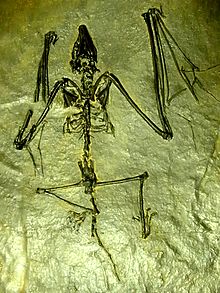
Leptictidium is an extinct genus of small mammals that were likely bipedal. Comprising eight species, they resembled today's bilbies, bandicoots, and elephant shrews. They are especially interesting for their combination of characteristics typical of primitive eutherians with highly specialized adaptations, such as powerful hind legs and a long tail which aided in locomotion. They were omnivorous, their diet a combination of insects, lizards and small mammals. Leptictidium and other leptictids are not placentals, but are non-placental eutherians, although closely related. They appeared in the Lower Eocene, a time of warm temperatures and high humidity, roughly fifty million years ago. Although they were widespread throughout Europe, they became extinct around thirty-five million years ago with no descendants, probably because they were adapted to live in forest ecosystems and were unable to adapt to the open plains of the Oligocene.

The Messel pit is a disused quarry near the village of Messel about 35 km (22 mi) southeast of Frankfurt am Main, Germany. Bituminous shale was mined there. Because of its abundance of well-preserved fossils dating from the middle of the Eocene, it has significant geological and scientific importance. Over 1000 species of plants and animals have been found at the site. After almost becoming a landfill, strong local resistance eventually stopped these plans and the Messel pit was declared a UNESCO World Heritage Site on 9 December 1995. Significant scientific discoveries about the early evolution of mammals and birds are still being made at the Messel pit, and the site has increasingly become a tourist site as well.
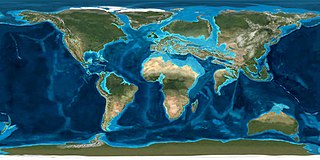
In the geologic timescale the Ypresian is the oldest age or lowest stratigraphic stage of the Eocene. It spans the time between 56 and47.8 Ma, is preceded by the Thanetian Age and is followed by the Eocene Lutetian Age. The Ypresian is consistent with the lower Eocene.

Icaronycteris is an extinct genus of microchiropteran (echolocating) bat that lived in the early Eocene, approximately 52.2 million years ago, making it the earliest known definitive bat. Four exceptionally preserved specimens, among the best preserved bat fossils, are known from the Green River Formation of North America. The best known species is I. index. Fragmentary material from France has also been tentatively placed within Icaronycteris as the second species I. menui. I. sigei is based on well-preserved fragments of dentaries and lower teeth found in Western India. In 2023, the species I. gunnelli also from the Green River Formation was distinguished from I. index, and I. menui and I. sigei were proposed to be removed from the genus due to them not being closely related.

Palaeochiropteryx is an extinct genus of bat from the Middle Eocene of Europe and North America. It contains three very similar species – Palaeochiropteryx tupaiodon and Palaeochiropteryx spiegeli, both from the famous Messel Pit of Germany, as well as Palaeochiropteryx sambuceus from the Sheep Pass Formation. They are usually found complete and exceptionally preserved, even retaining the outlines of their fur, ears, and wing membranes.
Tingamainus is a species of early placenta bearing mammal.
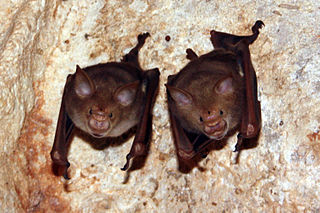
The Hipposideridae are a family of bats commonly known as the Old World leaf-nosed bats. While it has often been seen as a subfamily, Hipposiderinae, of the family Rhinolophidae, it is now more generally classified as its own family. Nevertheless, it is most closely related to Rhinolophidae within the suborder Yinpterochiroptera.
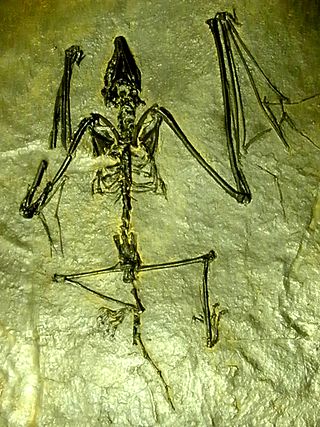
Archaeonycteris is an archaic bat genus whose fossilised remains have been found in Germany, France, England and India.

Cupes is a genus of beetles in the family Cupedidae. The Cupedidae are typical “reticulate” or “net-winged” beetles with incompletely sclerotized elytra that produce the characteristic reticulate appearance.
Australonycteris is an extinct and monotypic genus of microchiropteran bat with the single species Australonycteris clarkae. The species is known from fragmentary remains found at the Murgon fossil site, in south-eastern Queensland, dating to the early Eocene, 54.6 million years ago. It is the oldest bat from the Southern Hemisphere and one of the oldest bats in the world, and inhabited forests and swampy areas, with a diet of insects and possibly small fish.
Indobune is an extinct genus of ungulate endemic to Asia during the Eocene from 55.8—48.6 Ma, living for approximately 7.2 million years.
The Murgon fossil site is a paleontological site of early Eocene age in south-eastern Queensland, Australia. It lies near the town of Murgon, some 270 km north-west of Brisbane. The Murgon site is important as the only site on the continent with a diverse range of vertebrate fossils dating from the early Paleogene Period, making it a crucial period in mammal evolution. It is also important in demonstrating Australia's Gondwanan links with South America in the form of similar fossils from the two continents.

Palaeochiropterygidae is a family of extinct bats. It was originally erected by the Swiss naturalist Pierre Revilliod in 1917 after discoveries of Palaeochiropteryx fossils from the Messel Pit of Germany. Palaeochiropterygidae was merged into Archaeonycteridae by Kurten and Anderson in 1980, but modern authorities specializing in bat fossils maintain the distinction between the two. It was classified to the unranked clade Microchiropteramorpha by Smith et al. in 2007.
The Lignites de Soissonais is a geologic formation in the Var, Marne departments of France. It preserves fossils dating back to the Ypresian stage of the Eocene period.
Cambaytherium is an extinct genus of placental mammals in the family Cambaytheriidae whose fossils were found in an open pit coal mine located in Gujarat, India. The mine was a treasure trove full of teeth and bones, over 200 of which were identified as belonging to Cambaytherium thewissi. The fossils were dated to the Early Eocene, 54.5 million years ago, making them slightly younger than the oldest known fossils belonging to the order Perissodactyla.
Onychonycteridae is an extinct family of bats known only from the early Eocene of Europe and North America. The type species, Onychonycteris finneyi, was described in 2008 from two nearly complete skeletons found in the Green River Formation of southwestern Wyoming. Since that time a number of previously described fossil bat species have been assigned to Onychonycteridae, as well as two more recently discovered species.
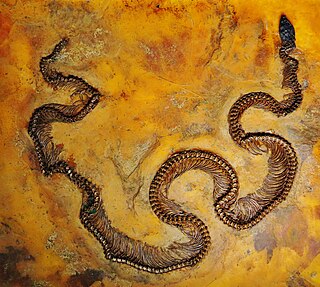
Eoconstrictor is an extinct genus of booid snake, which supposedly had infrared vision, from the Eocene of Germany. The type species, E. fischeri is known from multiple well-preserved specimens found in the Messel Pit of Germany. It was originally named as Palaeopython fischeri by Stephan Schaal in 2004, but examination of the genus showed that it represented a distinct lineage; it was renamed as the new genus Eoconstrictor in 2020. In a subsequent study Georgalis, Rabi & Smith (2021) reinterpreted "Paleryx" spinifer from the Eocene Geiseltal Lagerstätte as the second species species belonging to the genus Eoconstrictor. Palci et al. (2023) named the third species belonging to this genus, E. barnesi described on the basis of fossils from the Geiseltal Lagerstätte.
Jens Lorenz Franzen was a German paleontologist. He was the head of Paleoanthropology and Quaternary at Naturmuseum Senckenberg in Frankfurt and participated in fossil excavation in Germany. He worked with scientific excavations and discovered many previously unknown fossil mammal species.
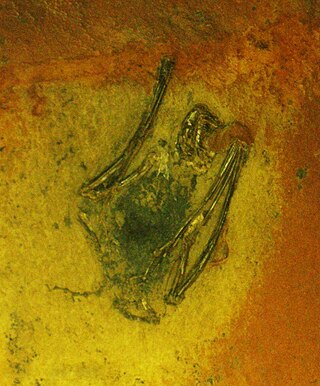
Hassianycteris is an extinct genus of Early Eocene (Ypresian) bats from the Hassianycterididae with two or three known species: the type, found in the Messel pit, Germany, H. kumasi, found in the Cambay Shale Formation, India, and the possible third species "H." joeli, found in the Kortijk Clay Formation, Belgium. Alongside Palaeochiropteryx tupaiodon, P. tupaiodon and Hassianycteris kumari are the first fossil mammals whose colouration has been discovered: both were reddish-brown when alive. H. messelensis was probably a similar colour when alive.
This is an overview of the paleofauna of the Eocene Messel Formation as explored by the Messel Pit excavations in Germany. A former quarry and now UNESCO World Heritage Site, the Messel Formation preserves what once were a series of anoxic lakes surrounded by a sub-tropical rainforest during the Middle Eocene, approximately 47 Ma.
